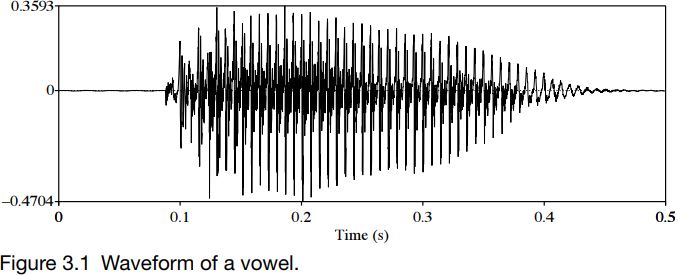


 Grammar
Grammar
 Tenses
Tenses
 Present
Present
 Past
Past
 Future
Future
 Parts Of Speech
Parts Of Speech
 Nouns
Nouns
 Verbs
Verbs
 Adverbs
Adverbs
 Adjectives
Adjectives
 Pronouns
Pronouns
 Pre Position
Pre Position
 Preposition by function
Preposition by function 
 Preposition by construction
Preposition by construction
 Conjunctions
Conjunctions
 Interjections
Interjections
 Grammar Rules
Grammar Rules
 Linguistics
Linguistics
 Semantics
Semantics
 Pragmatics
Pragmatics
 Reading Comprehension
Reading Comprehension|
Read More
Date: 2023-12-06
Date: 2024-01-03
Date: 2023-08-15
|
Waveforms are a kind of graph. Graphs have an x-axis, which runs horizontally, and a y-axis, which runs vertically. In waveforms of speech, the x-axis represents time and is usually scaled in seconds or milliseconds, while the y-axis shows (to simplify a great deal) amplitude, a representation of loudness.

Figure 3.1 shows a waveform of a vowel. On the x-axis, time is marked at 0.1 second (or 100 ms) intervals. On the y-axis, there is a line marked 0 (the zero crossing) which goes through the waveform. The bigger the displacement from this line, the louder the sound is. The beginning and end of this waveform have no displacement from the zero crossing line, so the recording begins and ends with a period of silence. The sound starts just before 0.1 s into the recording, and is loudest around 0.2 s. From a little after 0.2 s to around 0.45 s, the sound gets quieter: or, a little more technically, the amplitude decreases. By about 0.45 s, the signal has died away.
With a little experience and practice, various other kinds of sound are also evident in waveforms. We will look at these after we have considered spectrograms.
|
|
|
|
لخفض ضغط الدم.. دراسة تحدد "تمارين مهمة"
|
|
|
|
|
|
|
طال انتظارها.. ميزة جديدة من "واتساب" تعزز الخصوصية
|
|
|
|
|
|
|
مشاتل الكفيل تزيّن مجمّع أبي الفضل العبّاس (عليه السلام) بالورد استعدادًا لحفل التخرج المركزي
|
|
|